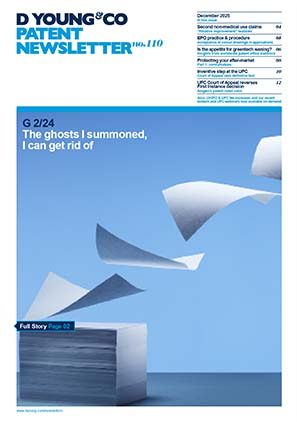EPO & UPC interplay: added subject matter by intermediate generalisation
The interplay between the European Patent Office (EPO) and the Unified Patent Court (UPC) is of great interest to European practitioners. In this article, we therefore examine a recent decision from the EPO Technical Boards of Appeal which explains divergence from an earlier UPC Court of Appeal decision on the topic of added subject matter by intermediate generalisation.
In decision T 1535/23, the EPO Board of Appeal revoked Pfizer’s patent (EP3431475) on the grounds of added matter and specifically because of an intermediate generalisation regarding the parent application under Article 76(1) EPC. In reaching its decision, the Technical Board of Appeal acknowledged an earlier decision of the UPC Court of Appeal (Abbott v Sibio, UPC_CoA_382/2024), which had dealt with added matter due to intermediate generalisation. The Technical Board of Appeal highlighted that the UPC Court of Appeal had:
- used the same test as applied by the EPO as its “gold standard” (G 2/10, OJ EPO 2012, 376), but
- came to a different conclusion on intermediate generalisation because of the facts underlying the case before it.
This is an interesting development because it highlights how the EPO Boards of Appeal appear to be keeping a watchful eye on the developing case law of the UPC.
Background to T 1535/23
The appeal concerned auxiliary request 5 as maintained following opposition proceedings. Claim 1 of auxiliary request 5 was directed to a method of making a crystalline free base of the compound “palbociclib”. The claim specified palbociclib as having: (a) a powder X-ray diffraction pattern comprising specific peaks; and (b) a primary particle size distribution within a specific range.
Claim 1 of auxiliary request 5 was derived from independent claim 19 of the parent application as filed. This claim was also directed to a method of making a crystalline free base of palbociclib, but did not state the above characteristics (a) and (b) of palbociclib. Rather, claim 19 of the parent application specified that the compound had a specific surface area of ≤ 2 m2/g. The absence of the specific surface area from claim 1 of auxiliary request 5 was the central issue considered by the board.
Added matter assessment
When assessing compliance with Article 76(1) EPC, the Technical Board of Appeal acknowledged that there were various passages in the parent application as filed which taught characteristics (a) and (b) of the palbociclib free base in claim 1 of auxiliary request 5.
However, it was found that the parent application did not suggest that the specific surface area could be omitted in the characterisation of the free base form. That is, the specific surface area was considered an essential feature of the invention disclosed in the parent application.
In its reasoning, the Technical Board of Appeal explained that the passages relied upon by the patentee referred to embodiments all having this specific surface area, and that claim 1 of auxiliary request 5 included embodiments having a specific surface area larger than 2 m2/g. Hence, the omission of this feature added subject matter beyond the content of the application as filed.
UPC_CoA_382/2024
The topic of intermediate generalisation was recently considered by the UPC Court of Appeal in Abbott v Sibio (UPC_CoA_382/2024). Decisions on added matter are often fact-specific and so it is notable that the Technical Board of Appeal in T 1535/23 found it necessary to comment on why its conclusion was not in contradiction with the decision of the UPC Court of Appeal (Reasons 1.7 of T 1535/23).
In UPC_CoA_382/2024, independent claim 1 of the patent related to an on-body glucose-monitoring device comprising a sensor assembly and an enclosure with an electronics assembly. The point of dispute was whether the omission of an elastomeric sealing member for sealing the coupling between the sensor assembly and the electronics assembly added subject matter.
The UPC Court of Appeal found that as the original application disclosed a need for sealing and several methods to achieve sealing, the skilled person would understand that the specific method of sealing (for example, an elastomeric seal) was not necessary for achieving the overall aim of the invention. Therefore, omission of the elastomeric sealing member did not extend beyond the content of the application as filed.
In reaching its conclusion, the UPC Court of Appeal did not explicitly mention the European Patent Convention (EPC) or any case law of the EPO Boards of Appeal. In T 1535/23, however, the Technical Board of Appeal noted that the UPC Court of Appeal had in fact used “the same test as applied by the EPO as its gold standard (see also G 2/10, OJ EPO 2012, 376)”, that is, “what the skilled person would derive directly and unambiguously using his [sic] common general knowledge and seen objectively and relative to the date of filing, from the whole of the application as filed”.
The Technical Board of Appeal then justified why it had come to the “opposite conclusion” on omission of a feature. It reasoned that the divergence in outcomes of the two cases was not a result of a difference in legal considerations, but rather a difference only in the facts of the respective cases. As a final remark the Technical Board or Appeal noted: “both the Court of Appeal and the board in this case, and the EPO in general, use the same principle in judging whether an amendment extends beyond the content of the application as filed” (emphasis added).
The Technical Board of Appeal’s mention of “the EPO in general” suggests a general willingness of the EPO to align with the UPC. This is a welcome approach to parties using the EPO and the UPC for their European patent portfolio.
Case details at a glance
Decision level: Court of Appeal
Parties: Abbott Diabetes Care Inc v Sibio Technology Limited, Umedwings Netherlands BV
Citation: UPC_CoA_382/2024
Date: 14 February 2025
Decision: dycip.com/upc-coa-282-2024
Decision level: Technical Board of Appeal
Parties: Pfizer Inc (proprietor) va STADA Arzneimittel AG, Teva Pharmaceutical Industries Ltd, Galencium Health SLU and Generics (UK) Limited (opponents)
Citation: T 1535/23
Date: 02 June 2025
Decision: dycip.com/epo-appeal-t153523



